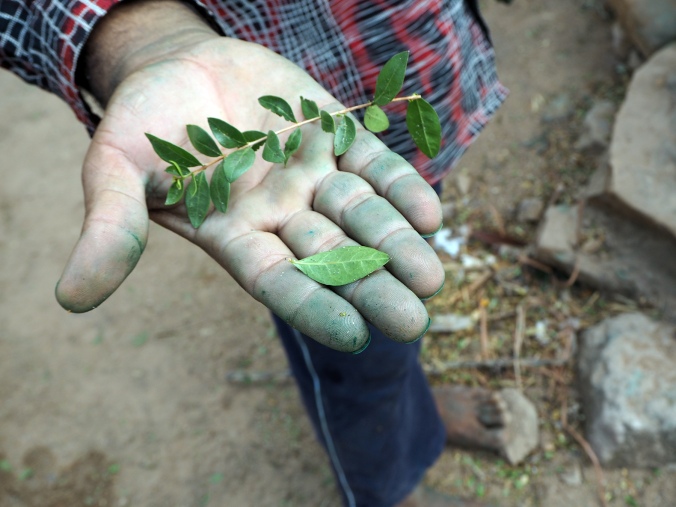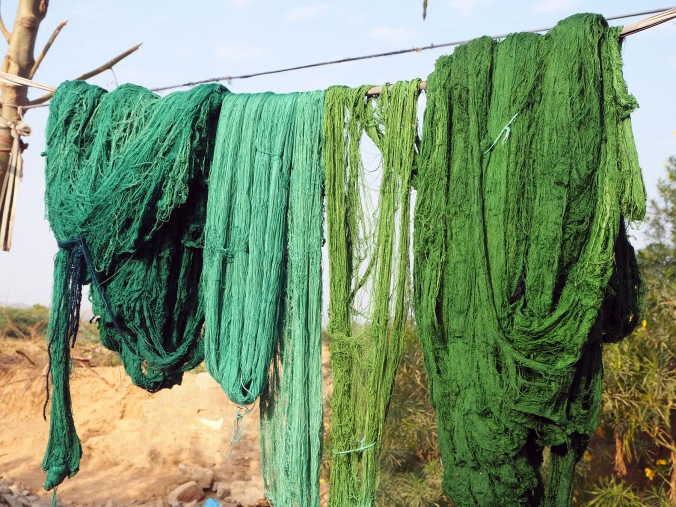For textile tragics like me, Kachchh, in the western region of Gujarat, is a treasure trove!
Departing Ahmedabad on the Pune/Bhuj Express, I headed west to Bhuj, the major town in the western region of Gujarat, Kachcch (Kutch). The seven-hour train trip passed quickly in my tiny, dirty but private 1AC compartment (first class air con – read: private with door and fan) for the 359km trip. For most of the time I caught up on some much-needed sleep and when awake, trying to keep up with these missives.
The scenery for the most part was beige, rendered even beiger by the train windows that look they have not been cleaned since this train was first commissioned, who know how many decades ago. Dry dusty landscape with low shrubs, shabby suburbs and tatty towns, did not engage me or the camera.
As soon as I arrived in town though, I could feel that this was a place I was really going to like. My hotel is situated I the old city – 17th century palaces, city walls and gates strong enough to repel rampaging elephants (seriously) nestle beside modern (boring) cement houses and apartments and village style huts and animal shelters. The main market is two minute’s walk away and along the way chai, snacks and nimbu paani sellers (the latter is a refreshing and healthy mixture of fresh lime juice, soda and black salt) line the narrow streets. The people are extremely friendly and a foreign face in their midst is a catalyst for many conversations. I feel a basic honesty here too, and there seems to be a sense of contentment with people I meet.

View through the gate to the Prag Mahal with spikes to repel elephants, 17th century city wall and chai stall. The gate is closed every night and opened in the morning.
My hotel is tucked into a street so narrow there is no room for two autoricks to pass, and hard up against the old city wall. A short walk following the wall takes me to a city gate through which is the Royal Family of Kachchh residences: the Prag Mahal and Aina Mahal.
Prag Mahal is named after Rao Pragmalji II, who commissioned it and construction began in 1865. It was designed by Colonel Henry Saint Wilkins in the Italian Gothic style, and many Italian artisans were involved in its construction. Construction of the palace, which ultimately cost 3.1 million rupees, was completed in 1879 during the regency of Khengarji III (Pragmalji II’s son) after his father’s death.The local Kutchi builder community were also involved in construction of Prag Mahal. I took a 2 hour tour of the two palaces with a lovely man I met who had been curator of the Aina Mahal for 30 years and had seen all manner of royalty come and go there.

And the real thing – or they were once upon a time. Now reduced to dusty decomposing trophies in the Prag Mahal.
There is still much evidence about of the earthquake that ravaged this area in 2001, killing about 20,000 people. Chunks of carved stone from ancient buildings can be found in piles on the street, waiting to be used in the ongoing restoration work. The Prag Mahal was severely damaged, but is in the process of restoration.
But it is the textiles that have drawn me to this far-flung region of India. The villages of Kachchh have a long tradition of hand woven and hand embroidered textiles. Many of the people in this area came as refugees from Pakistan after the Indo-Pakistan war in 1971 and were settled by the government in this area. One applique panel I have acquired tells the story of the exodus from the old country.
Each region and each tribal group can be identified by the style of their embroidery. Until recently, this work was completely made for domestic purposes: wedding garments and dowry items, baby toys and blankets, wall, door and window decoration, shopping and document bags, children’s bonnets with special ear protection from the desert cold and wind – anything and everything the villagers needed for daily life was a piece of embroidered art. This makes for wonderful colourful traditions, but did not add economic value to the households. That is, until organisations like Kala Raksha and Khamir were formed with the express purpose of maintaining the traditional work as well as teaching the makers to redesign their work for the marketplace. These organisations are great advocates for the artisans of the area and both have very professional retail outlets – a joy to visit, and a great temptation to spend! And spend I did… have some lovely new stock for Kasu Emporium.

This lovely lady sits in the sun and sews tiny dolls – stock for the Kala Raksha shop. She spent most of her life doing detailed embroidery, but now her eyes are not strong enough to do the fine detailed work.
I have just returned from the market in my part of town where I found a tiny shop selling antique Kachcchi embroidered pieces. Man! So much beauty in one place! So I bought a few things didn’t I? They may or may not turn up for sale at Kasu Emporium……..
In the morning , I had met up with Kuldip, a local tour guide whom I had connected with on FaceBook some months ago. He will assist me with the next tour I am planning to Gujarat and this afternoon he took me to a weaving village close by Bhuj. We met a family of weavers who specialize in traditional Kachcchi weaving and mashroo in particular (cotton warp and silk weft in a satin weaving style). Babubhai, the father of the family demonstrated a complicated weaving technique on his pit loom, feet dancing across a series of wooden pedals as the design is created, and his brother gave a demonstration of the supplementary thread technique for creating individual motifs in a plain field. They also showed us the dying techniques using vegetation from around the village which they supplement with chemical dyes to obtain the colours they need.
Hospitality is the hallmark of all Indian families, and village hospitality is particularly warm. Chai was made and enjoyed as we sat in the open sided lean-to to view Babubhai’s finished work. Shawls and sample swatches were presented with detailed explanations of the techniques employed, the fibres and dyes. Such beauty coming from these simple looms! I have bought a few pieces – one of each only will be available through Kasu Emporium. The others, of course stay in my personal collection as a physical reminder of the unforgettable few hours spent with Babubhai and his lovely family.










How wonderful-a feast for the senses and such welcoming people to give you insight into their culture and traditions. i cant imagine you will be under baggage limits coming home to Australia-but how could you resist. the beauty and craftsman ship is incredible.
Debxxx
Sent from Windows Mail
LikeLike
The secret to buying is to find a post office soon afterwards & send it home. Then there will be some lovely parcels to come home to.
LikeLike
Fabulous Beverley. Enjoying the blog very much. Margaret
LikeLike
That’s great Margaret, glad you’re enjoying… more coming soon.
LikeLike
Your portraits show the beauty of the people as well as their art…
LikeLiked by 1 person
Pingback: The Cloth & Stone Tour to Gujarat – destinations and experiences | Kasu Tours